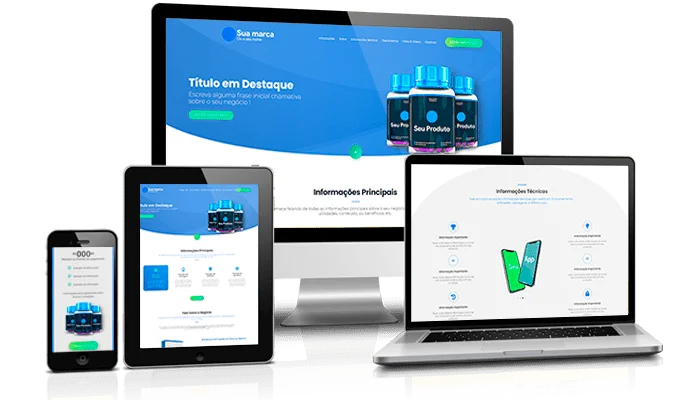The world of digital marketing, already complex, is now moving at the speed of light. For those looking to scale results and optimize time, AI tools for digital marketing automation are no longer a luxury, but a necessity.
They transform overwhelming tasks, from content creation to audience segmentation, into efficient and intelligent processes. The battle for attention has become fiercer than ever, and the strategic use of Artificial Intelligence is the key to standing out.
This is not an article about “AI trends.” Technology changes, but the need for automation and optimization is a permanent pillar of marketing. This guide is a practical and conceptual manual to help you understand what truly matters when choosing and implementing AI tools. We’ll demystify the jargon, focus on real use cases, and show how these technologies can free up your time and boost your results.
Get ready to transform your digital marketing strategy by leaving repetitive work to the machines and focusing on human creativity and strategy.
What “AI tools for digital marketing automation” truly means
Before we dive into the tools, it’s crucial to understand what we are trying to achieve. Traditional marketing automation relies on predefined rules (e.g., “if a user clicks on link A, send email B”). Automation with AI takes this to a new level, adding the ability to learn, adapt, and act based on real-time data.
Imagine AI as your smartest marketing assistant. It can:
- Create Content at Scale: Generate text for blogs, emails, social media captions, and ads in a matter of minutes, while maintaining brand consistency.
- Personalize the Customer Journey: Analyze user behavior to send the right message, at the right time, to the right person, across channels like email, SMS, or push notifications.
- Optimize Ad Campaigns: Automatically adjust bids, targeting, and creative assets to maximize return on investment (ROI).
- Analyze Sentiment and Behavior: Monitor what customers are saying about your brand on social media and identify trends to improve products and services.
- Predict Trends: Analyze large volumes of data to predict which products will be in high demand or which marketing strategies will be most successful.
The big takeaway is that AI solves the problem of scalability. It allows a single marketing professional, freelancer, or small business owner to do the work of an entire team, focusing on high-impact tasks instead of manual, repetitive work.
The anatomy of AI tools for digital marketing automation: Essential features
The market is flooded with tools that promise miracles. What do you really need? Let’s break down the most important features and get to know the tools that offer them.
1. Content Generation (AI Copywriting)
This is the most popular feature and a starting point for many. Tools that use AI to generate text for any purpose:
- Blog Articles: Can create drafts or complete articles from a title or keyword.
- Ads and Landing Pages: Generate persuasive copy optimized for conversion.
- Marketing Emails: Create personalized email sequences to nurture leads or recover abandoned carts.
- Social Media Content: Suggest captions and ideas for posts.
For this category, Jasper is the standout tool. With Jasper, you can scale content production while maintaining your brand’s voice. It works on a monthly subscription, with plans that vary based on the number of words generated.
Why is Jasper the best choice?
Jasper’s main differentiator is its level of sophistication and its ability to generate high-quality content at scale. While many AI copywriting tools offer basic features, Jasper goes further with capabilities that truly matter to a professional or business:
- Long-form and Coherent Text Generation: Unlike other tools limited to short sentences or paragraphs, Jasper is optimized for creating longer blog articles and more extensive content. It can maintain the text’s coherence and flow for hundreds or thousands of words, a challenge for most AIs.
- Multiple Content Models (Templates): Jasper is not just a text generator. It offers dozens of specific templates for different marketing needs, such as:
- Copywriting Frameworks: AIDA (Attention, Interest, Desire, Action) and PAS (Problem, Agitate, Solution).
- Social Media Content: Generation of captions, post ideas, and YouTube titles.
- Ad Copy: Texts optimized for Google Ads and Facebook Ads.
- Marketing Emails: Email sequences and subject lines. This variety allows the user to create content for their entire marketing strategy on a single platform.
- Ability to Learn the “Brand Voice”: One of Jasper’s most powerful features is the ability to train it with your brand’s voice. You can provide examples of texts your company has already published, and the AI will learn the tone, style, and vocabulary, ensuring all generated content is consistent and authentic. This is crucial for companies that value their brand identity.
- Integration with SEO Tools: Jasper integrates directly with SurferSEO, a content optimization tool we cover in the article. This integration allows you to create and optimize your text for SEO in real time, without having to switch between platforms.
- Reputation and Trust: Jasper is one of the most established and trusted AI tools on the market, with a solid user base and positive testimonials. For affiliation, this is fundamental as it increases the credibility of your recommendation and the likelihood of conversion.
In short, the choice of Jasper is not just based on the fact that it “generates text,” but on its ability to do so strategically, at scale, and with high quality, solving real-world, day-to-day problems for professionals and content creators.
2. SEO Optimization (AI SEO)
For those who want to go beyond text creation and dominate search engines, AI SEO tools are essential. They analyze the competition and suggest strategies to optimize your content:
- Competitive Analysis: Identifies the keywords your competitors are using and suggests content gaps.
- On-Page Optimization: Gives real-time suggestions to improve your content’s SEO score, such as keywords to include, titles, and meta descriptions.
- Schema Markup Creation: Automatically generates the code to highlight your content in search results.
For on-page optimization, SurferSEO is the ideal tool. SurferSEO uses AI to analyze your competitors’ content and gives you an SEO “score,” suggesting what needs to be improved. It’s a paid tool, but the return on organic traffic can be extremely high.
Why is SurferSEO the best choice?
The main advantage of SurferSEO is its ability to transform competitive analysis into clear instructions for your content. Most SEO tools provide data, but SurferSEO translates that data into an “action plan.” Here’s why it stands out:
- Data-Driven Competitive Analysis: Instead of guessing what Google wants, SurferSEO analyzes the pages already ranking in the top positions for your keyword. The software’s AI studies these competitors and identifies optimization patterns, such as:
- Keywords and related terms that competitors use.
- Topic structure (the most common subheadings and sections).
- Ideal word count for the article.
- Number of images and internal/external links.
- Content Score: This is its most powerful feature. SurferSEO gives you a real-time score as you write, indicating how optimized your content is. The tool acts as an “SEO personal trainer,” giving direct suggestions on what to include in the text to increase the score and, consequently, the chances of ranking.
- Keyword and Content Cluster Tools: The AI in SurferSEO helps you find not just the main keyword, but also related terms and questions your audience is searching for. It also groups keywords by relevance, helping you create “content clusters” that support each other, strengthening your domain’s authority.
- Integration with Copywriting Tools: Native integration with tools like Jasper allows you to create SEO-optimized content in a single workflow. You don’t have to generate text in one tool and then optimize it in another, which saves a huge amount of time.
- Intuitive Interface and Direct Action: SurferSEO stands out for its ease of use. It doesn’t overwhelm the user with raw data. Instead, it focuses on a clean interface that guides the user step-by-step through content optimization.
In short, the choice of SurferSEO is not just a recommendation for “another SEO tool.” It’s an endorsement of a solution that automates the most complex part of content optimization, allowing you to focus on the quality and value of your article with the confidence that it was built with SEO best practices in mind.
3. Email Marketing Automation and CRM
This feature goes beyond mass emails, making customer communication hyper-personalized. AI can:
- Predictive Segmentation: Identifies which users are most likely to buy and automatically segments them into personalized lists.
- Send Time Optimization: Analyzes email open behavior and sends your campaigns at the time each user is most likely to interact.
- Optimized Subject Lines: Generates and tests subject lines to maximize open rates.
A notable example in this category is HubSpot. Known for its robust CRM, HubSpot uses AI to automate email sequences and intelligently segment your audience. The platform has a free plan and paid plans with advanced features.
Why is HubSpot the best choice?
The choice of HubSpot as the top tool for Email Marketing Automation and CRM is strategic because it’s not just an email software, but a complete platform that integrates marketing, sales, and customer service. Its main advantage is the ability to unify all customer data, allowing for truly intelligent and personalized automation.
HubSpot: The All-in-One Solution
While other tools focus only on email automation, HubSpot offers a complete suite of interconnected features, creating a 360-degree view of the customer.
- Native CRM Integration: This is its most powerful feature. HubSpot was born as a CRM (Customer Relationship Management). This means that with every interaction (email open, link click, page visit, material download), the data is automatically logged in the customer’s profile. The platform’s AI uses this information to segment and personalize campaigns far more accurately than isolated tools.
- Behavior-Based Automation: HubSpot’s AI automation goes beyond simple rules. It allows you to create complex and personalized workflows. For example, the platform can:
- Send a special offer email to a customer who has visited the pricing page three times but hasn’t purchased.
- Send a “Welcome” email based on their browsing history and preferences.
- Automatically alert the sales team when a lead is “hot” and ready to be contacted.
- Comprehensive Marketing Tools: In addition to email, HubSpot includes tools for:
- Landing Page Creation: High-conversion pages to capture leads, which automatically connect to the CRM.
- Social Media Management: Schedule and analyze posts in one place.
- Content Analytics: Tools to measure the performance of blog articles, e-books, and other materials.
- Freemium Model (and scalability): HubSpot offers a very robust free plan, allowing freelancers and small businesses to start using the CRM and email automation at no cost. As the business grows, they can upgrade to paid plans with more advanced features.
- Market Recognition: HubSpot is an undisputed leader in the marketing automation and CRM market. Its reputation and vast ecosystem of integrations (with over 1,000 apps) make it a safe and long-term choice for any business.
In short, the choice of HubSpot is justified by its ability to be a complete and integrated solution. It not only automates email sending, but it also optimizes the entire customer journey, from the first contact to conversion and loyalty, all on a single intelligent platform.
4. Paid Ad Optimization (PPC AI)
For those who manage paid traffic campaigns, AI is a game-changer. It allows you to optimize bids and creative assets in real time to maximize ROI.
- Bid Management: Adjusts bids to maximize returns, surpassing the human ability for 24/7 monitoring.
- Dynamic Creative Creation: Creates multiple ad variations (with different images and text) and tests which combination performs best.
- Keyword Analysis: Suggests new high-performance keywords and optimizes the matching of search terms.
AdCreative.ai focuses on something very specific: the creation of ad creatives. AdCreative.ai uses AI to generate ad variations that are more likely to convert. It’s a paid subscription service, ideal for those who invest in paid traffic frequently.
Why is AdCreative.ai the best choice?
The main advantage of AdCreative.ai is its ability to automate the creation of high-converting visual ads in a matter of seconds, using artificial intelligence to optimize the process. Its differentiation comes from:
- Platform-Optimized Creative Generation: The tool is trained with millions of data points from successful ads on Facebook, Google, LinkedIn, and other platforms. Based on this, the AI knows which combinations of colors, fonts, layouts, and images are most likely to generate clicks and conversions for a specific niche. This eliminates guesswork and time spent on manual A/B testing.
- Solution for “Creative Block”: For traffic managers and business owners, the constant need to create new ads can lead to creative burnout. AdCreative.ai solves this problem by generating hundreds of high-quality ad variations with just a few clicks, allowing the focus to be on strategy, not production.
- Focus on Performance Data: The software doesn’t just create ads; it also optimizes them. The tool analyzes your campaign’s performance and suggests which creatives are working best, allowing you to allocate your budget to what truly delivers results.
- Integration and Ease of Use: AdCreative.ai easily integrates with the most popular ad platforms (like Google Ads and Meta Ads), allowing you to export the creatives directly to your campaigns. The interface is intuitive, making it accessible for beginners but powerful enough for experienced professionals.
- Relevance and ROI: The creative asset is one of the most important factors for a successful ad campaign. A good creative can reduce the cost per click and increase the return on investment (ROI). AdCreative.ai positions itself as a tool that directly addresses this variable, which justifies its value and affiliate potential.
In short, AdCreative.ai stands out because it solves a specific, high-impact problem in the world of PPC. It automates the creative process, turning it into a data-driven process, which is essential for any advertiser looking to maximize their results.
5. Analytics and Reporting
Collecting data is easy, but transforming it into insights is the big challenge. AI can:
- Sentiment Analysis: Analyzes comments and brand mentions to understand public perception.
- Trend Prediction: Analyzes past customer behavior to predict future actions.
- Smart Reports: Transforms complex data into visual reports and executive summaries.
In this field, Semrush stands out. It’s a complete marketing suite that uses AI for various features, from competitor analysis to keyword suggestions. Semrush is a robust tool, ideal for agencies and more experienced professionals.
Why is Semrush the best choice?
The main reason for choosing Semrush is its ability to provide a 360-degree view of your digital marketing strategy from a single dashboard. It’s not just an analytics software, but a true center for competitive intelligence. Its differentiation comes from:
- In-depth Competitive Intelligence: Semrush uses AI to analyze the traffic of any competitor. It shows where traffic comes from (organic, paid search, social media, etc.), which are your competitors’ most profitable keywords, which ads are generating the most results, and even their link-building strategies. This intelligence allows you to not only analyze your own data but also learn from the market.
- AI-powered Performance Reports: The tool generates intelligent reports that go beyond the numbers. It uses AI to identify anomalies, growth opportunities, and emerging trends. For example, it can alert you to a sudden drop in traffic to a specific page or suggest trending keywords for your niche.
- Content Strategy Analysis and Optimization: Semrush isn’t limited to data. It has a “Content Marketing” tool that uses AI to help you create content that truly stands out. It suggests topics based on what your audience is searching for and provides an “SEO template” with the ideal keywords and structure for ranking well.
- Scalability and Comprehensiveness: The platform offers more than 50 tools in one place. This means that, in addition to analysis and reports, you can manage SEO optimization, paid traffic (PPC), social media, and even content marketing without leaving the platform. This is ideal for agencies and professionals who need a complete solution.
- Market Recognition: Semrush is a global leader in digital marketing, with a solid reputation and a massive user base. Its reliability and the volume of data it processes make it the definitive source of analysis for millions of professionals worldwide.
In short, Semrush was chosen because it transforms data analysis into a strategic and proactive process. It not only shows you what happened but also helps you understand why it happened and what you need to do to improve your results.
Comparative Table of AI Tools for Digital Marketing Automation
To make your article a quick reference, here is a comparative table with the mentioned tools, their pricing models, and their main uses.
| Tool | Main Feature | Pricing Model | Ideal For… |
|---|---|---|---|
| Jasper | Content Generation | Per-word subscription | Content creators, blogs |
| SurferSEO | SEO Optimization | Monthly/annual subscription | SEO professionals and agencies |
| HubSpot | Automation and CRM | Freemium (paid by features) | Marketing and sales teams |
| Semrush | Marketing Analytics | Freemium (paid by features) | Marketing agencies, specialists |
| AdCreative.ai | Creative Generation | Monthly subscription | Paid traffic managers |
Real-World Use Cases: How AI Tools for Digital Marketing Automation Solve Everyday Problems
To illustrate the power of AI, let’s see how it applies to different professional profiles.
Case 1: The Content Marketing Freelancer
Problem: The demand for content is high, but production capacity is limited by time and “writer’s block.”
AI Solution: The freelancer uses a tool like Jasper to generate the initial drafts of 10 articles in a single day. The AI creates the structure, titles, and introductory paragraphs. The freelancer then focuses on reviewing, adding their human touch, and deepening the research, cutting production time in half. With the time saved, they can take on more clients or focus on SEO strategies for their current ones.
Case 2: The E-commerce Entrepreneur
Problem: The abandoned cart rate is high, and communication personalization is a challenge.
AI Solution: The entrepreneur uses a marketing automation tool like HubSpot. The platform identifies users who have added products to their cart but haven’t completed the purchase. Instead of sending a generic email, the AI analyzes the user’s website browsing history and generates an email with an offer or a complementary product that is more likely to drive conversion. The result is a significant increase in the cart recovery rate.
Case 3: The Paid Traffic Manager
Problem: The ad budget is limited and competition is fierce. The manager spends hours optimizing bids and adjusting segmentations.
AI Solution: A tool like AdCreative.ai takes control of bid management. It analyzes ad performance every second, adjusting bids to ensure the best cost per click (CPC) and cost per acquisition (CPA). The tool also automatically tests different ad versions, discovering which combination of image and text generates more clicks, freeing the manager to focus on audience strategy and expanding to new platforms.
How to Choose Between AI Tools for Digital Marketing Automation: A Practical Guide
Choosing the right tool depends on your needs and budget. Follow this strategic process.
Step 1: Define Your Goals
What is your biggest pain point in digital marketing?
- Need more content? Focus on copywriting tools, like Jasper.
- Want more organic traffic? Focus on SEO tools, like SurferSEO.
- Want to improve communication with your customer base? Focus on email marketing automation tools, like HubSpot.
Step 2: Evaluate Integration and Usability
A standalone tool has no value. Check if it integrates with the platforms you already use (e.g., your CRM, your e-commerce platform, Google Analytics). Usability is crucial. The interface needs to be intuitive, because if the tool is difficult to use, it will be abandoned.
Step 3: Consider the Pricing Structure
Most AI tools for marketing operate on a subscription model (SaaS). They might charge based on the number of users, the number of automated tasks, or the volume of data processed.
Tip: Use the free trial periods. Most high-quality SaaS companies offer trials of 7 to 30 days. Use that time to simulate a real-world use case and see if the tool delivers on its promises.
Step 4: Research Reputation and Support
Look for reviews on platforms like Capterra, G2, and Product Hunt. Check the quality of customer support. An AI tool is complex, and having good support to answer questions is essential.
Step 5: Test, Test, Test!
Don’t commit to a tool without thoroughly testing it. Create a small test campaign. Generate some text, optimize an article, automate an email, and analyze the results. The best tool is the one that proves to be useful and effective for your specific needs.
❓ FAQ Frequently Asked Questions about AI tools for Digital Marketing Automation
No. AI does not replace, it augments the capabilities of professionals. It automates repetitive tasks, allowing humans to focus on strategy, creativity, empathy, and relationship building. AI is a powerful tool in the hands of a marketing professional, not a substitute.
Yes, many of them are. Most AI tools for marketing operate on a SaaS (Software as a Service) business model, offering flexible plans. Many platforms, like HubSpot and Semrush, have “freemium” plans that allow you to start for free. The paid plans are often scalable, with prices that adjust to your volume of use, making them accessible to businesses of all sizes.
The most advanced AI tools, such as Jasper, are trained with vast volumes of data to ensure originality. However, the best use of AI is as a starting point. The ideal approach is to use the generated content as a draft or inspiration so you can review it, edit it, and add your unique knowledge and brand voice. The human touch is still irreplaceable for creating authentic, high-quality content.
Integration is the key point. AI tools for marketing automation are designed to integrate with other platforms you already use, such as your CRM, your website (WordPress, Shopify, etc.), and your ad accounts (Google Ads, Meta Ads). This integration allows data to flow seamlessly, ensuring that the AI has all the information it needs to optimize your campaigns and personalize communication with your customers.
Conclusion on AI tools for Digital Marketing Automation: Embrace the revolution and multiply your results
Artificial Intelligence is not a threat to marketing professionals; it is a strategic partner. It handles repetitive, data-driven tasks, freeing you to focus on creativity, human connection, and high-level strategy.
By following the guidelines in this guide, you will be well-positioned to choose the right tools, optimize your processes, and multiply your results. The AI revolution in digital marketing has already begun.
The question isn’t whether you’ll join in, but when. And your success depends on starting now.
Did you like the content? Share it with someone who needs to optimize their marketing strategies!
If you enjoy articles about how to use AI commercially, check out our other article Artificial intelligence in commerce, learn how to use it to personalize customer service, products, and services.
Click here for more content on Technology & News.








